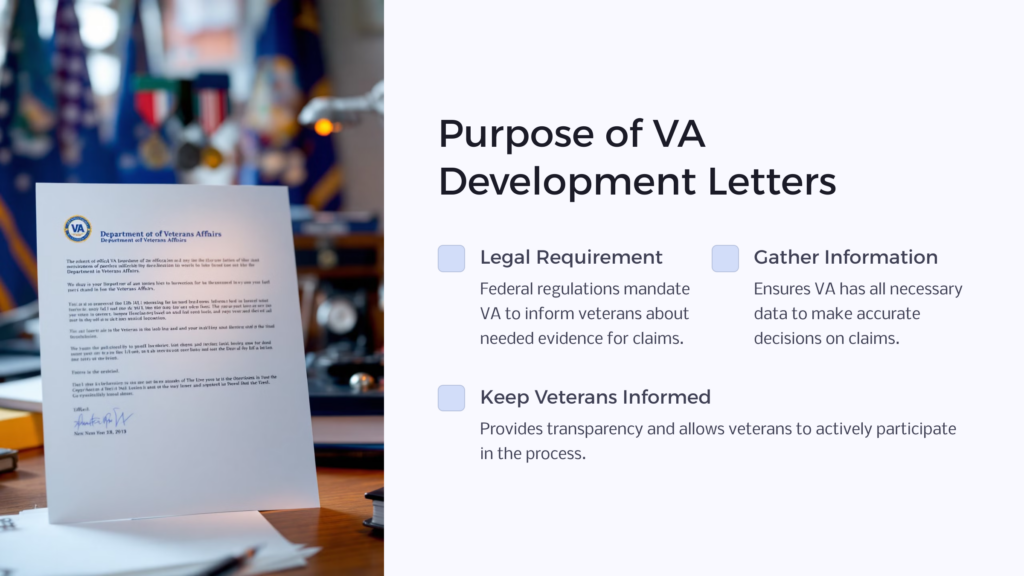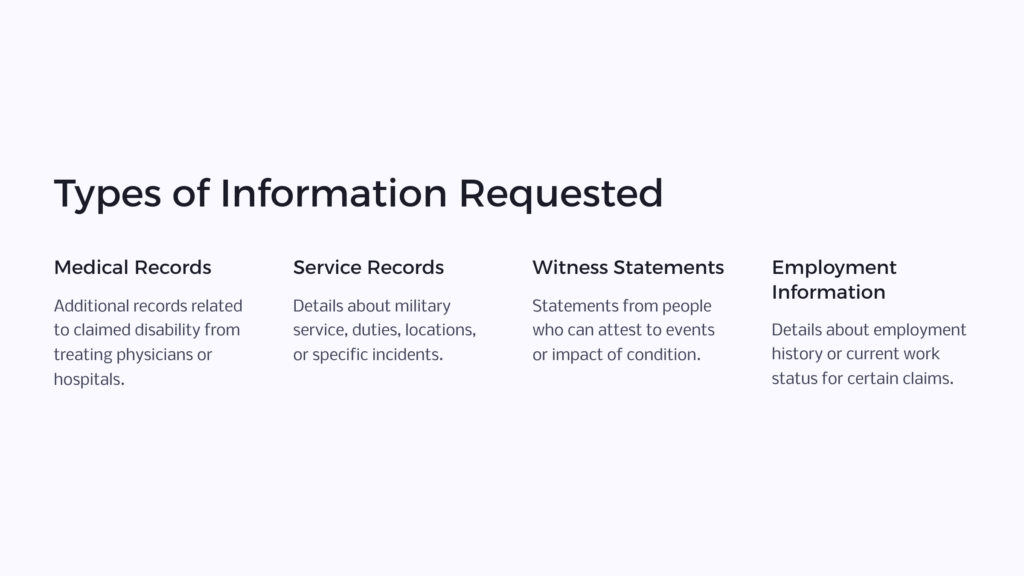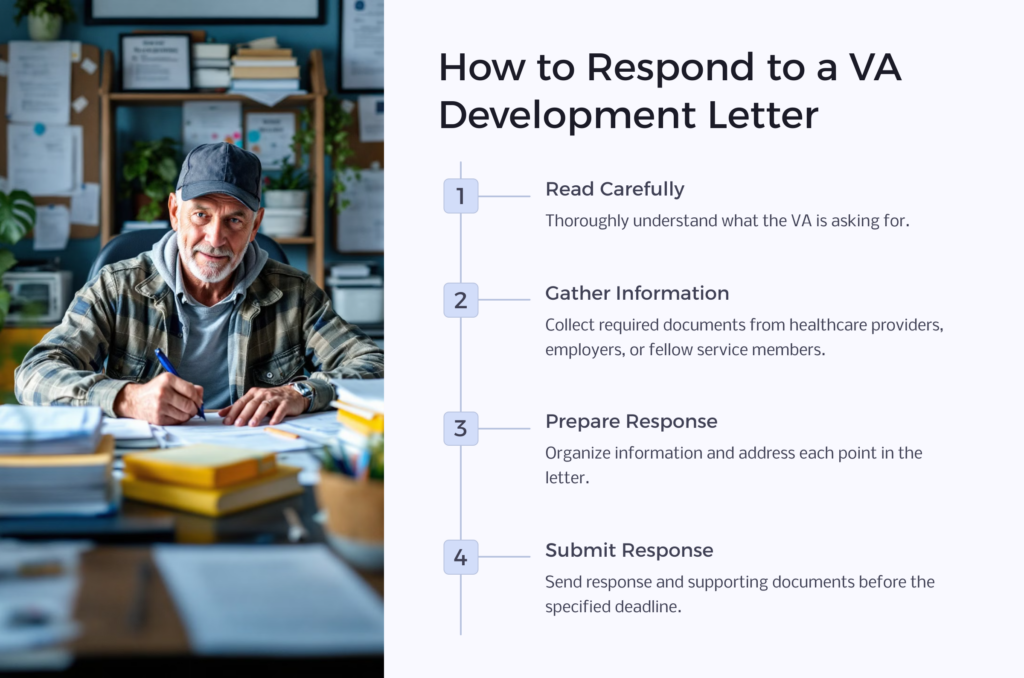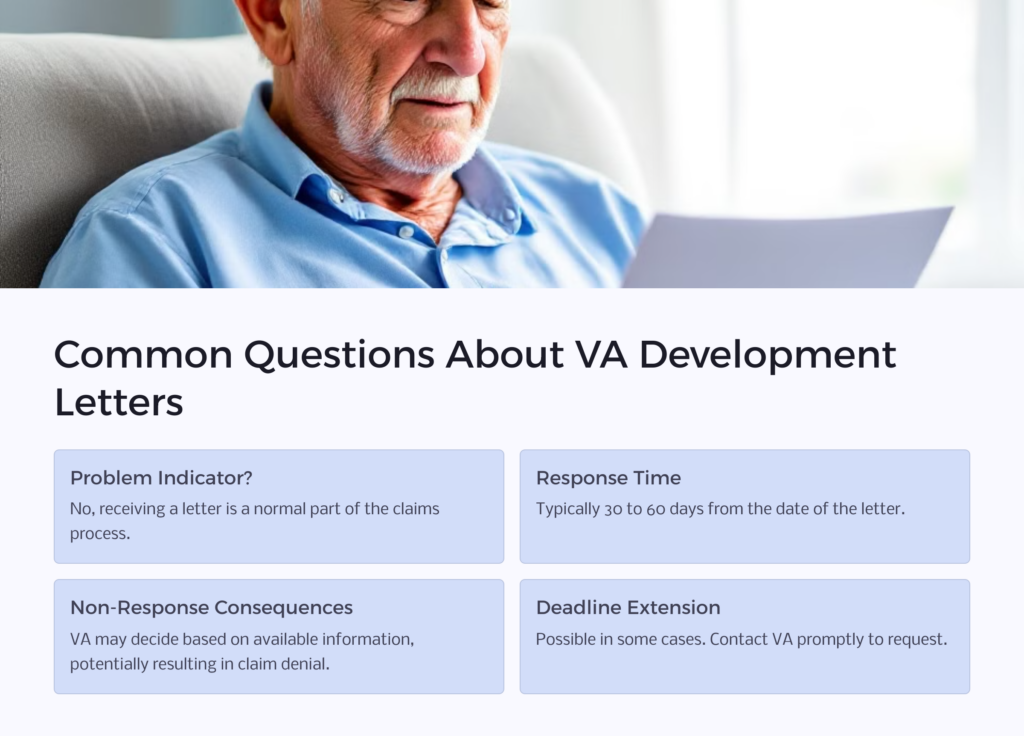A VA development letter, also known as a VA claim notification letter, is an official communication sent by the Department of Veterans Affairs (VA) to veterans who have filed a disability claim. This letter serves as an update on the status of your claim and typically requests additional information or evidence needed to process your claim accurately.
VA development letters are an essential part of the VA disability claim process. They are designed to help the VA gather all necessary information to make a fair and informed decision about your claim. These letters are not meant to be alarming or indicate a problem with your claim; rather, they are a standard part of the process to ensure that your claim is thoroughly evaluated.
Understanding what a VA development letter is and how to respond to it can significantly impact the outcome of your claim. It’s crucial to read these letters carefully and take appropriate action to provide the requested information or evidence within the specified timeframe.

Why Does the VA Send Development Letters?
The VA sends development letters for several important reasons. First and foremost, these letters are a legal requirement. Federal regulations mandate that the VA must inform veterans about the evidence needed to support their claims and provide instructions on how to submit this evidence.
Another key reason for sending development letters is to ensure that the VA has all the necessary information to make an accurate decision on your claim. The VA disability claim process can be complex, and each claim is unique. By requesting specific information or evidence, the VA can fill in any gaps in your claim file and avoid making decisions based on incomplete information.
Development letters also serve as a way for the VA to keep you informed about the status of your claim. They provide transparency in the process and give you an opportunity to actively participate in supporting your claim. By responding to these letters promptly and thoroughly, you can help expedite the decision-making process and potentially improve the outcome of your claim.
Key Components of a VA Development Letter
A typical VA development letter contains several important components that you should pay close attention to. Understanding these elements will help you respond effectively and ensure that your claim continues to progress smoothly.
1. Claim Status Update: The letter will usually begin with an update on where your claim stands in the review process. This might include information about which stage of the process your claim is in, such as initial review or evidence gathering.
2. Missing Evidence: A crucial part of the letter is the list of any additional evidence or information the VA needs to continue processing your claim. This could include medical records, service records, or other supporting documents.
3. Deadlines: The letter will specify a due date or timeframe for submitting the requested information. Typically, this is between 30 and 60 days from the date of the letter. It’s crucial to note this deadline and respond before it passes to avoid delays in your claim.
4. Contact Information: The letter should provide details on how to reach the VA representative handling your claim. This information is valuable if you have questions or need assistance with your response.
By familiarizing yourself with these key components, you’ll be better equipped to understand and respond to your VA development letter effectively.
Types of Information Requested in VA Development Letters

VA development letters may request various types of information or evidence, depending on the specifics of your claim. Understanding the common types of requests can help you prepare and gather the necessary documentation more efficiently.
Medical Records: The VA often requests additional medical records related to your claimed disability. This could include records from your treating physicians, hospitals, or other medical facilities. If you’ve received treatment for your condition outside of VA facilities, you may need to provide these records or give the VA permission to obtain them.
Service Records: In some cases, the VA may need more information about your military service. This could include specific details about your duties, locations of service, or incidents that occurred during your service. You might be asked to provide additional service records or fill out forms detailing your experiences.
Statements from Witnesses: For certain types of claims, such as those related to post-traumatic stress disorder (PTSD), the VA might request statements from people who witnessed the events related to your claim or can attest to how your condition has affected you.
Employment Information: If your claim involves unemployability or impacts your ability to work, the VA may request information about your employment history or current work status.
Remember, the specific information requested will depend on the nature of your claim and what evidence is already in your file. It’s important to provide as much relevant information as possible to support your claim.
How to Respond to a VA Development Letter

Responding to a VA development letter promptly and thoroughly is crucial for the progress of your claim. Here’s a step-by-step guide on how to effectively respond:
1. Read the letter carefully: Take the time to thoroughly understand what the VA is asking for. If anything is unclear, don’t hesitate to contact the VA representative mentioned in the letter for clarification.
2. Gather the requested information: Start collecting the required documents or information as soon as possible. This might involve contacting healthcare providers, former employers, or fellow service members.
3. Prepare your response: Organize the information you’ve gathered. Make sure to address each point mentioned in the development letter. If you’re unable to provide certain requested information, explain why in your response.
4. Submit your response: Send your response and any supporting documents to the VA before the deadline specified in the letter. It’s advisable to use certified mail with a return receipt to ensure your response is received and to keep a record of when it was sent.
5. Keep copies: Make copies of everything you send to the VA. This will be helpful if you need to reference this information later or if the VA misplaces any documents.
Remember, responding to a VA development letter is your opportunity to strengthen your claim. Providing thorough and accurate information can significantly impact the outcome of your claim.
Common Questions About VA Development Letters

Veterans often have questions about VA development letters. Here are answers to some of the most frequently asked questions:
Q: Does receiving a VA development letter mean there’s a problem with my claim?
A: No, receiving a development letter is a normal part of the claims process. It simply means the VA needs more information to properly evaluate your claim.
Q: How long do I have to respond to a VA development letter?
A: The letter will specify a deadline, typically 30 to 60 days from the date of the letter. It’s crucial to respond before this deadline to avoid delays in your claim.
Q: What happens if I don’t respond to a VA development letter?
A: If you don’t respond, the VA may make a decision based on the information they already have, which could result in a denial of your claim or a lower rating than you deserve.
Q: Can I get an extension on the deadline?
A: In some cases, yes. If you need more time to gather the requested information, contact the VA as soon as possible to request an extension.
Q: What if I can’t provide all the requested information?
A: Provide as much information as you can and explain why you’re unable to provide the rest. The VA will consider your explanation when evaluating your claim.
Remember, if you have any questions not addressed here, don’t hesitate to contact the VA or seek assistance from a veterans service organization or a VA-accredited attorney.
Viewing Your VA Development Letter Online
Many veterans wonder if they can view their VA development letter online. While the VA has made significant strides in digitalizing their processes, VA development letters are not typically available for online viewing.
However, you may receive a notification on your VA.gov account that a development letter has been sent to you. This notification serves as an alert that you should expect to receive a physical letter in the mail soon.
If you haven’t received your letter within a reasonable timeframe after seeing this notification (usually about two weeks), you can take action. You can call the VA at 800-827-1000 and request that an operator email you a copy of the letter. This can be particularly helpful if you’re concerned about mail delays or if you need to access the information quickly.
While the VA continues to improve its online services, it’s important to keep your mailing address up to date with the VA to ensure you receive all important correspondence, including development letters.
What to Do If You Don’t Receive Your VA Development Letter
Sometimes, despite the VA’s best efforts, you might not receive your development letter. This can happen for various reasons, such as an incorrect mailing address or postal service issues. If you believe you should have received a VA development letter but haven’t, here are some steps you can take:
1. Check your VA.gov account: Look for any notifications about a development letter being sent. This can confirm whether a letter was indeed mailed to you.
2. Contact the VA: Call the VA at 800-827-1000 to inquire about the status of your development letter. They can confirm if and when a letter was sent and to what address.
3. Update your address: If you’ve moved recently, make sure the VA has your current mailing address on file. You can update your address online through your VA.gov account or by contacting the VA directly.
4. Request a copy: As mentioned earlier, you can ask the VA to email you a copy of the development letter. This ensures you have the information you need to respond, even if the physical letter never arrives.
5. Check your spam folder: If you’ve requested an email copy, make sure to check your spam or junk mail folder in case the email was filtered out.
Remember, it’s your responsibility to keep the VA updated with your current contact information. Regularly checking your VA.gov account and maintaining open communication with the VA can help prevent issues with receiving important correspondence.
Impact of VA Development Letters on Your Claim
VA development letters play a crucial role in the outcome of your disability claim. Understanding their impact can help you appreciate the importance of responding promptly and thoroughly.
Firstly, these letters directly affect the processing time of your claim. By providing the requested information quickly, you can help expedite the decision-making process. Conversely, delays in responding can lead to prolonged processing times or even result in a decision being made without all the necessary information.
Secondly, the information you provide in response to a development letter can significantly influence the VA’s decision on your claim. This is your opportunity to strengthen your case by providing additional evidence that supports your claim. Detailed medical records, comprehensive statements, and other relevant documentation can help the VA better understand the nature and severity of your disability.
Lastly, your response to a development letter demonstrates your active participation in the claims process. This engagement can be viewed favorably by the VA, showing that you’re committed to providing all necessary information for a fair evaluation of your claim.
Remember, while receiving a development letter might feel like a setback, it’s actually an opportunity to bolster your claim and ensure the VA has all the information needed to make an accurate decision.
Tips for Avoiding Common Mistakes with VA Development Letters
When dealing with VA development letters, there are several common pitfalls that veterans should be aware of and try to avoid:
1. Ignoring the letter: One of the biggest mistakes is simply not responding to the development letter. Always respond, even if you don’t have all the requested information.
2. Missing the deadline: Pay close attention to the due date specified in the letter and make every effort to respond before this deadline.
3. Providing incomplete information: Try to address all the points mentioned in the letter. If you can’t provide certain information, explain why in your response.
4. Sending original documents: Always send copies of documents, not originals. The VA may not return original documents, and you might need them for future reference.
5. Assuming the VA has certain information: Don’t assume the VA already has access to your medical records or service history. If they’re asking for something, it means they need it from you.
6. Not keeping copies: Always make copies of everything you send to the VA. This helps you keep track of what you’ve submitted and can be crucial if you need to reference this information later.
7. Providing irrelevant information: While it’s important to be thorough, avoid sending information that’s not related to your claim. Stick to what’s been requested to avoid confusion or delays.
By avoiding these common mistakes, you can help ensure a smoother process and potentially improve the outcome of your claim.
Next Steps After Receiving a VA Development Letter
After you’ve received and responded to a VA development letter, you might be wondering what comes next. Here’s what you can expect:
1. Confirmation of receipt: The VA should acknowledge receipt of your response. If you don’t receive confirmation within a reasonable timeframe, consider following up with the VA.
2. Further review: The VA will review the additional information you’ve provided. This process can take some time, so patience is key.
3. Possible additional requests: In some cases, the VA might send another development letter if they need further clarification or additional information. Be prepared to respond promptly if this happens.
4. Decision preparation: Once the VA has all the necessary information, they will prepare to make a decision on your claim.
5. Decision notification: You will receive a decision letter informing you of the outcome of your claim. This letter will explain the VA’s decision and provide information about your rights if you disagree with the decision.
6. Consider next steps: If you’re satisfied with the decision, no further action is needed. If you disagree, you have the right to appeal. Consider seeking assistance from a VSO or VA-accredited attorney to guide you through the appeals process.
Remember, the VA claims process can be lengthy, but staying engaged and responsive throughout can help ensure the best possible outcome for your claim. Keep all documentation related to your claim, including copies of your development letter and your response, in case you need to reference them in the future. Start today by checking us out at Benefits.com and take our quiz to see if you qualify.
 Benefits.com Advisors
Benefits.com Advisors
With expertise spanning local, state, and federal benefit programs, our team is dedicated to guiding individuals towards the perfect program tailored to their unique circumstances.
Rise to the top with Peak Benefits!
Join our Peak Benefits Newsletter for the latest news, resources, and offers on all things government benefits.





















